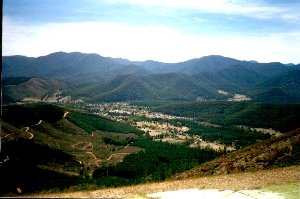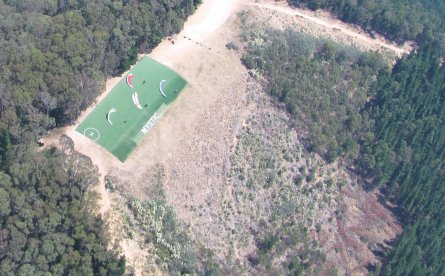Victoria > East Inland
Mystic

| Type | Inland, Ridge, Mountain |
| Conditions | N (valley wind) |
| Height | 797m / 2614' asl, 477m / 1564' agl |
| Rating | PG4 / HG Intermediate. PG2 and PG3 require PG4 supervision. HG Sup require HG Int supervision. |
Approximately 3.5 hours drive from Melbourne in the Victorian Alps. Vicroads Map 49 H6.
000 Emergency Markers (?)
- MYS080: Launch
- MYS034: Landing - Mystic LZ
Landowners
Landing is leased to local club.
Contact/Responsible
NEVHGCDescription
Mystic Hill is an excellent site which often works because it faces the valley wind and generates some strong thermals. It is located 2km south of Bright just off the road to Wandiligong. Mystic is one of the most popular Victorian inland sites, which has hosted numerous state and national competitions as well as the the Paragliding World Cup in 1998 and most recently, 2018. Current weather observations can be accessed via the Mystic weather station.
Financial Membership with the NEVHGC is required before flying Mystic, and can only be purchased from the club website at www.nevhgc.net using a PayPal account or credit card. Links to social media groups can be found on the club website, otherwise most pilots meet at the LZ on Morses Creek Road to car-pool up the hill.
From December 2019 restrictions have been introduced to reduce traffic on the access road to Mystic launch. NEVHGC members are still given free access for the purpose of flying and vehicle retrieve but will not be admitted if there are bikes in the vehicles. Access to launch is only via the principal Mystic Lane entry. All other access tracks have been closed off.
Eagle Attacks – most wedgetail eagles in the area are friendly, however there is a grumpy eagle resident on the Buffalo Foothills who may attack paragliders. Please see Site Page>Hazards for details.
For accomodation there are many options available in Bright, ranging from backpackers hostels, to caravan parks and luxury cottages. Camp Crusty (with cabins and camping) is the closest option to the landing zone of Mystic.
Takeoff
 Take off is right next to the road and is unobstructed as all pine trees have been cut down over the entire face of the hill. It boasts the safest launch area (about 100m wide) of all the sites in this region. If possible, have one of the numerous local pilots show you the site for the first time as there are some shortcomings which have caught many pilots off guard. At T/O the landing paddock cannot be seen as it is shielded by the spur to the east. It is a good idea to survey the landing paddock first and then on the drive up, stop as you round the spur and sight it again from above before you fly.
Take off is right next to the road and is unobstructed as all pine trees have been cut down over the entire face of the hill. It boasts the safest launch area (about 100m wide) of all the sites in this region. If possible, have one of the numerous local pilots show you the site for the first time as there are some shortcomings which have caught many pilots off guard. At T/O the landing paddock cannot be seen as it is shielded by the spur to the east. It is a good idea to survey the landing paddock first and then on the drive up, stop as you round the spur and sight it again from above before you fly.
Landing
For paragliders and hang gliders (if they can tolerate the relatively short approach), there is a new landing ground on the right hand side of the road on the way to Wandilagong. A car park is situated at the end of the landing ground.
The main bombout for hang gliders is across the Wandiligong rd, east of the smaller paddock. Look for the stile over the fence. The main dangers are the trees (normally) upwind producing turbulence, as the valley breeze blows most of the time from the NW. Expect turbulence on any normal summer's day.
Before going XC, please check the map for allowed and forbidden landing paddocks in the area.
Flight
Ridge soaring, once above the height of the trees behind launch is quite easy (but sometimes bumpy). In order to get to that height, passes across the launch bowl in the best lift are often required. Once below launch height, head towards the landing paddock and you may be lucky and catch a thermal above the spur on the way down. When thermalling there are a number of places to head for. Thermals seem to gather above the spurs to the left and right. In general, the whole hill is a trigger point so be prepared for some monster lift straight away. During summer, the lift is quite strong and rough between 12 and 3:30pm. It is safer and more enjoyable to launch before or after. Many excellent XC flight have been achieved after launching as late as 5:30pm. During other seasons Bright hill can be flown almost anytime.
The site is centred amongst prime alpine flying country, so excellent XC flights are possible. Over the back to Harrietville, right to Tawonga Gap and the Kiewa Valley, or left to Porepunkah Hill, the Ovens Valley, Mt Buffalo, Myrtleford and onwards. On epic days try for Wangaratta or the McDonalds on the Hume Highway SW of Wangaratta.
Waypoints for the Bright area can be found here.
Hazards / Comments
Strong lift in summer during the middle of the day. Power lines along road beside landing ground. Large expanses of 'tiger' country to south, and between Pyramid Hill and the Kiewa valley.
Mt Buffalo Eagles
There are many Wedge-tailed eagles resident in the Ovens Valley. The great majority are friendly, will join you in a thermal or show you where the lift is better. However, a number of eagles are territorially aggressive, will attempt to warn you out of their area and may attack your wing if you do not leave. The greatest number of such incidents have occurred in recent years in the vicinity of Little Buffalo.
The eagle’s nest is on the shoulder of Little Buffalo and the eagle has been known to patrol anywhere on that spur and the adjacent Buffalo Foothills. His patrol area is outlined in brown but he has been known to attack out in the valley as far as the airfield.
Attacks may occur at any time of year but are more frequent when the eaglets are being raised between October and March. The eagle’s job is to drive us away from his nest. If you do as he asks he probably won’t attack. Attacks have not occurred to a wing which is over 1,500m and may not occur as low as 1,100m. Heights of attacks are usually in the 800-1,000m range when wings are looking for lift on Little Buffalo or Buffalo Foothills. If flying in the area it is advised that you keep a vigilant look out. If you see the eagle, immediately turn away from him, his nesting area and the terrain.
He may pursue you, if so he will climb above and then attack your wing from behind usually going for your wing tips. You may hear him calling as he approaches – he sounds similar to a cat mewing. You may not hear that in which case the first you will know is when you feel a tug on the wing similar to a sharp thermal bubble. If you look up you will probably then see him fly past as he circles for another go. You can reduce the chance of him making contact with the wing by making steep wingovers. As he approaches from behind, pull a deep wing over on the side of his attack. He will not always be able to manoeuvre and follow the wing down and will have to circle back for another try. Keep doing that while at the same time leaving the terrain as fast as you can. As you get further out and away from his nest, it is probable that he will break off.
Damage to the wings is caused by the eagle’s three talons piercing the material and potentially tearing a section away. Damage can be anything from light nicks to the wing being a complete write off. We have no record of a wing being so damaged that it cannot be flown to a safe landing.
